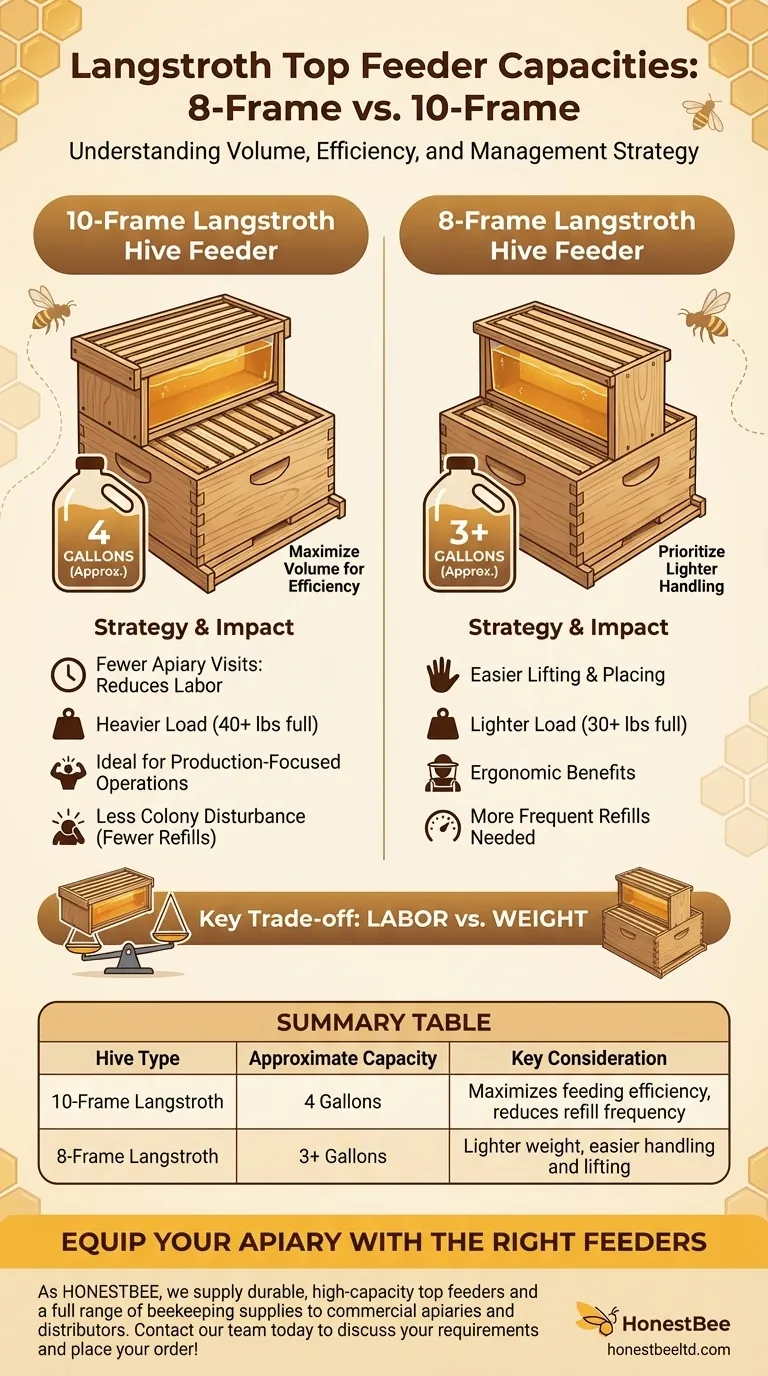For Langstroth beekeeping equipment, a standard top feeder designed for a 10-frame hive typically holds about 4 gallons of syrup. Its counterpart for an 8-frame hive is slightly smaller, holding just over 3 gallons. These capacities can vary modestly between different manufacturers and specific feeder designs.
The difference in feeder capacity is less about a simple volume measurement and more about aligning your feeding strategy with your overall hive management philosophy—choosing between the maximum efficiency of a 10-frame system or the lighter, more manageable components of an 8-frame system.
The Role of Feeder Capacity in Hive Management
Understanding the volume of a top feeder is the first step. The more critical task is to understand how that volume impacts your work and the health of your bees.
Why Capacity Dictates Strategy
The size of your feeder directly influences the frequency of your apiary visits. A larger reservoir allows you to provide a substantial amount of food at once, reducing the number of times you must open the hive.
This is crucial during critical periods like fall feeding for winter preparation or stimulating brood production in the spring. Fewer disturbances mean less stress on the colony.
The 10-Frame Standard: Maximizing Volume
The roughly 4-gallon capacity of a 10-frame top feeder is designed for efficiency at scale. For beekeepers managing multiple hives, this volume minimizes labor by extending the time between refills.
A full 4-gallon feeder provides a significant food source that a strong colony can draw upon for an extended period, making it the preferred choice for production-focused operations.
The 8-Frame Alternative: Prioritizing Handling
The 3+ gallon capacity of an 8-frame feeder is a direct reflection of the philosophy behind 8-frame equipment itself: easier handling.
An 8-frame hive box is narrower and lighter than a 10-frame box. The feeder follows suit. Since syrup weighs approximately 10 pounds per gallon, the ~10-pound weight difference between a full 10-frame feeder (40+ lbs) and an 8-frame feeder (30+ lbs) is significant.
Understanding the Trade-offs
Choosing a feeder size is an exercise in balancing convenience, colony needs, and your own physical comfort.
Labor vs. Weight
This is the central trade-off. The 10-frame feeder demands you lift a heavier load but requires fewer trips to the apiary. The 8-frame feeder is lighter and easier to place on the hive but will need to be refilled more often.
Hive Compatibility
While obvious, it is a critical point. A 10-frame feeder will not fit properly on an 8-frame hive body, and vice-versa. The feeder must match the width of the hive equipment you use.
Manufacturer Variations
Never assume capacity is exact. The "4-gallon" and "3-gallon" figures are reliable industry averages, but one manufacturer's design may hold slightly more or less than another's. Always check the specific product details before purchasing.
Making the Right Choice for Your Apiary
Your decision should be based on the type of hive equipment you run and your management style.
- If your primary focus is minimizing labor across many hives: The larger 4-gallon capacity of a 10-frame top feeder is the most efficient choice for your system.
- If your primary focus is easier lifting and handling: The 3-gallon capacity of an 8-frame top feeder perfectly complements the ergonomic benefits of an 8-frame hive.
- If you are starting out: Choose the feeder that matches your hive boxes, and be confident that both provide ample volume for supporting a colony.
Ultimately, selecting the right feeder capacity is about matching your equipment to your physical abilities and beekeeping goals.
Summary Table:
| Hive Type | Approximate Feeder Capacity | Key Consideration |
|---|---|---|
| 10-Frame Langstroth | 4 Gallons | Maximizes feeding efficiency, reduces refill frequency |
| 8-Frame Langstroth | 3+ Gallons | Lighter weight, easier handling and lifting |
Ready to equip your apiary with the right feeders? As HONESTBEE, we supply durable, high-capacity top feeders and a full range of beekeeping supplies to commercial apiaries and distributors. Our wholesale-focused operations ensure you get the reliable equipment you need to support your colonies efficiently. Contact our team today to discuss your requirements and place your order!
Visual Guide

Related Products
- HONESTBEE Professional Hive Top Bee Feeder Feeding Solution
- Professional In-Hive Bee Feeder HONESTBEE Frame for Beekeeping
- Professional Hive Top Bee Feeder for Beekeeping
- Classic Boardman Entrance Bee Feeder Hive Front Feeding Solution
- In-Hive Dual Compartment Frame Bee Feeder for Targeted Colony Nutrition
People Also Ask
- What is the best way to top feed bees? A Safe, High-Volume Feeding Solution for Your Apiary
- What features make top feeders a reliable choice for beekeepers? A Guide to Safe, Efficient Hive Nutrition
- What are the advantages of hive top feeders? Maximize Feeding Efficiency for Your Apiary
- What should be done with feeders and equipment after feeding bees? Essential Steps for Apiary Health
- What is a top feeder for bees? Maximize Colony Health with Efficient Feeding



















